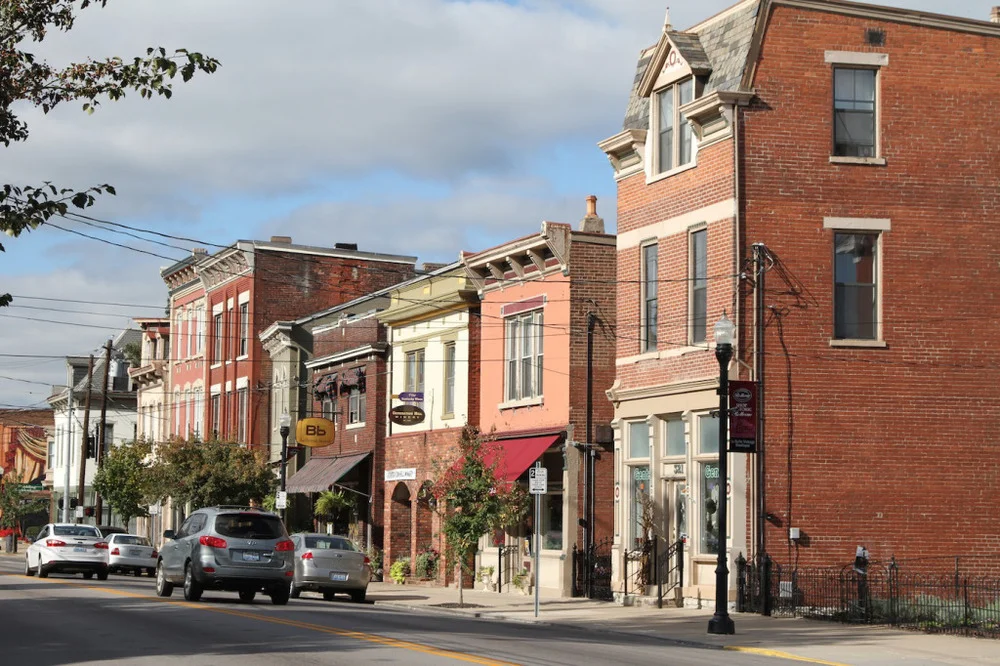Maumee, OH, Is Taking Back Its Streets—By Removing Them
This feature profile highlights the work being done in Maumee, one of the four finalists in the 2024 Strongest Town Contest. Cast your vote to determine the winner, or learn more about the contest, here.
Artist rendering of Uptown Maumee, OH.
Most North American infrastructure is overbuilt, creating a dangerous environment that municipalities cannot fiscally afford to maintain. That’s why Maumee, Ohio, is doing something different. Instead of sticking to outdated, post-WWII infrastructure designs, this town of nearly 14,000 people is taking bold steps to create neighborhoods that are safe, productive, and community oriented. To do this, they have reduced unnecessary street pavement, encouraged compact development, and eliminated parking minimums.
Like many U.S. towns, Maumee has a state highway that cuts through their Uptown. For decades, it’s been known as a dangerous road; one that has favored fast traffic and large semis over the people that live there. “I would never ever park my car on Conant Street, because I would be terrified that if I opened my door, it would get blown off,” said Nancy Gagnat, the city’s public information officer.
After observing how pedestrians avoided crossing the street because of how unsafe it felt, the city took action. In 2020, Maumee redesigned the city’s main thru-traffic corridor, Conant Street (State Route 25), to no longer be a highway barreling right through their Uptown.
By leveraging Ohio’s Home Rule law, the city transformed the state-owned highway; reducing it from four lanes to three and adding on-street parallel parking to further protect people walking. By incorporating arches and conserving mature street trees, the city made a safer and more inviting atmosphere.
These modifications along Conant Street have not only made for a more community-centric environment, but they’ve also altered driver behavior by deterring large semis and slowing traffic. Over time, the changes have actually increased traffic flow while also making Uptown safer for people walking and biking.
“We used to have six and half hours of backup on Conant Street in a 24-hour period,” said city administrator Patrick Burtch. “Now we have about two and half hours. And we carry more cars.”
Maumee’s efforts to rebuild the city aren’t stopping at Conant Street. Their redesign is spreading out onto nearby streets as they move the curb and narrow roads with each maintenance update. “We try to narrow every street we repave,” said Burtch.
The city has also begun to tackle their next most dangerous stroad: the Anthony Wayne Trail, or US 24, another state-owned highway. The stroad travels along Uptown, bypassing schools, restaurants, and the river. “It doesn’t feel like it’s unsafe to drive 100 mph,” said Burtch. “And we have had people traveling 100 mph.”
With the help of the Ohio Department of Transportation (ODOT), the city has reduced lane widths—removing around 16 feet of unnecessary pavement—by moving the curb.
“When we brought [these design changes] to ODOT, they realized what we were really proposing is to slow traffic through our community,” said Burtch. “And they embraced it.”
With upcoming additions, such as planting street trees, they’ll continue to create an environment that influences drivers speed through design.
“It’s very clear that speed kills pedestrians and motorists alike,” said Burtch. “And the numbers go up exponentially once you achieve 40 mph; those stats are clear.” But by narrowing lanes, and making it feel unsafe to drive over the speed limit, Maumee has the chance to save lives.
Additionally, by combining this street retrofit with the development of a 12-foot sidewalk (know as the Towpath), the river is now a place people go, versus just an area that cars pass through.
People using the Towpath.
Maumee doesn't just rely on street changes for a vibrant community. By transforming empty buildings and old parking lots, they are crafting a town that works smarter. Imagine dining in a once-abandoned bank turned into a charming restaurant: that is the type of efficient planning Maumee is creating. Instead of focusing on new businesses on the fringes of town, they’re asking: what can we do with the empty lots and buildings we already have?
“We didn't just start the road diet,” said Burtch. “We actually looked at some of the vacant lots in town and the repurposing of buildings.”
Without strict parking minimum laws in place, Maumee has the opportunity to reclaim vast areas of barren asphalt and transform them into vibrant spaces. The city's new street designs have purposely planned for this, as they created 227 new on-street parking spaces to make up for when the parking lots are eventually removed. Within the next decade, Maume plans to reduce at least 10% of their flat, unnecessary pavement.
“[The new parking] is equivalent to two major parking lots that don’t need to exist here,” said Burtch. “Those lots should be productive buildings.”
There’s work to be done to make your own town a Strong Town, and you don’t have to go it alone. Thousands of people across North America are working to make their community a better place. Join with others in your area, or start your own Local Conversation.













Seairra Jones serves as the Lead Story Producer for Strong Towns. In the past, she's worked as a freelance journalist and videographer for a number of different organizations. She currently resides between small-town Illinois and the rural Midwest with her husband, where they help manage a family homestead. When Seairra isn’t focusing on how to make our towns stronger, you can find her outside working on the farm, writing fictional tales in a coffee shop, or reading in a hammock.